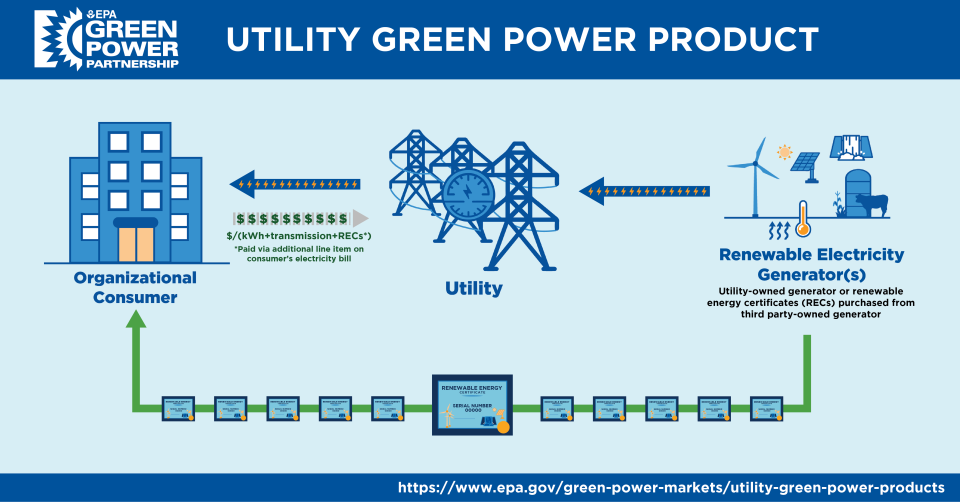Utility Green Power Products
Explore the sections below to learn more about utility green power products:
- What Is a Utility Green Power Product?
- How Do Utility Green Power Products Work?
- Advantages and Challenges of Utility Green Power Products
- Additional Resources
What Is a Utility Green Power Product?
A utility green power product is an optional green power product offered by a customer's default utility supplier. Sometimes referred to as “green pricing,” these are "bundled" products that include both renewable energy certificates (RECs) and electricity. Participating customers usually pay a per-kilowatt-hour (kWh) premium through an additional line item on their monthly electric utility bill to shift from the standard offering to renewable electricity.
Roughly 850 utilities nationwide, ranging from investor-owned to municipal and cooperative utilities, offer utility green power product(s) to their customers, 1 which can include both residential and commercial consumers. According to the National Renewable Energy Laboratory's (NREL’s) 2023 Status and Trends in the Voluntary Green Power Market (pdf) report, utility green pricing programs sold 16.6 billion kWh of renewable energy to 1,252,000 customers in 2022. 2
How do Utility Green Power Products Work?
Most utility green power products are structured as either block products or percent-of-use products. With the first type, customers choose how many “blocks” of renewable electricity to buy each month, usually in increments of 100 kWh (although some programs offer much larger block sizes to commercial customers). With a percent-of-use product, customers elect to source a percentage—perhaps 25 percent, 50 percent, or 100 percent of their electricity bill—from renewable sources, which means that their monthly green power use fluctuates with electricity usage. Customers can typically subscribe or unsubscribe to a utility green power program at any time, on a month-to-month basis.
When customers sign up for a green power product, the utility either generates the green power with renewable energy generators that it owns or procures it from elsewhere and retires RECs on behalf of the customer in proportion to the quantity of green power purchased by the customer.
The below infographic depicts how a typical Utility Green Power Product works.

Advantages and Challenges of Utility Green Power Products
Advantages:
- Easy procurement transaction with little expertise needed.
- Customers can maintain or expand upon existing relationship with default energy supplier.
- Customers can generally subscribe or unsubscribe at any time (e.g., no long-term contract).
- Procurement method is easy for customers to explain to stakeholders.
- Green power is often sourced from local or regional resources.
Challenges:
- Often has a larger price premium than other green power procurement options.
- Customer's default utility may not offer a green power program.
- May offer less of a direct connection to a specific renewable energy project.
- Customer usually has no say in composition of resource mix or which renewable energy projects the green power is sourced from.
Additional Resources
- National Renewable Energy Laboratory, 2001. Green Pricing Programs: What Defines Success? (pdf)
- NREL, 2023. Status and Trends in the U.S. Voluntary Green Power Market (2022 Data) (pdf).
- U.S. Department of Energy, Green Power Network. 2017. Accessed through the Wayback Machine, July 2018.
- https://www.nrel.gov/analysis/assets/pdfs/status-and-trends-2022-data.pdf
